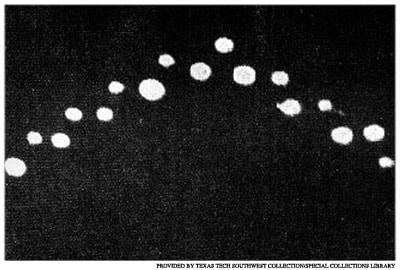
LUBBOCK, Texas — On August 25, 1951, a group of Texas Tech University professors gathered at one of their homes for a casual hang-out.
Around 9:20 p.m., it happened.
The professors reported seeing about 20-30 blue-yellowish lights fly above them. They said the objects were bright as stars and were traveling in the southern direction.
In a 2003 interview, Pat Allgood said that same night, saw a very similar formation at the drive-in movie.
“All of a sudden, my date and I saw these lights coming over the screen,” said Allgood. “It was just a formation of lights about the size of maybe a little bit smaller than a Frisbee.”
A few days later, on August 30, Carl hart Jr., a freshman at Texas Tech, said he was standing in his parents’ backyard when two V-shape formations of lights flew over him.
“I grabbed my camera and set the exposure where I wanted it and went back outside and waited, and then two more lights came over,” said Hart Jr. “I think I got two pictures of one and three of the other.”
Hart Jr. processed his images and took them to the Lubbock Avalanche-Journal. The newspaper was hesitant to publish them at first but eventually did. Hart Jr.’s images were published in LIFE magazine a few months later.
The group of Texas Tech professors contacted the Air Force about the sightings because they were confident what they saw were not meteors.
“We’re talking about professional people who apparently were impressed enough by having seen strange things in the sky to go and try to observe them under scientific condition,” said Donald Burleson, a retired professor from Roswell, New Mexico.
These events would later be known as the Lubbock Lights.
In declassified military documents obtained by EverythingLubbock.com, both the professors and Hart Jr. were interrogated multiple times about the sightings as part of the U.S. government’s “Project Grudge” investigation (later known as Project Blue Book).
“They went over and over my story to, I guess, try to catch me being inconsistent, but apparently they were satisfied eventually,” said Hart Jr.
Federal investigators eventually realized Hart Jr.’s images were unedited. The declassified documents revealed they contacted nearby military installments like Reese Air Force Base to confirm if the lights were military aircraft or missiles.
Air Force officials confirmed the lights were neither one of those.
Shortly after, Lt. Edward Ruppelt, leader of the Project Grudge investigation, determined the lights were “plover-like” birds that had reflected light from Lubbock’s newly installed streetlights.
According to the declassified documents, investigators met with the Federal Game Warden to discuss their “plover-like” bird theory. The FGW doubted the lights were birds because plovers were not prevalent in the Lubbock area at that time of year.
Local biology experts said the objects were too big to be birds.
After 70 years, the U.S. Air Force has not revised its “plover-like” theory about the Lubbock Lights.
“Often in the popular culture, the phrase UFO has been associated with aliens, but it really just stands for unidentified flying object,” said current Texas Tech professor Thomas Maccarone. “Many kinds of unidentified flying objects are things that are just normal, natural phenomena, but we don’t understand what they are well enough, based on the kinds of observations we have of them.”
In his 1956 book The Report on Unidentified Flying Objects, Lt. Ruppelt wrote, “they were not birds, refracted light, or spaceships…they were positively identified as a very commonplace and easily explainable natural phenomenon.”
Matt Stell
No comments:
Post a Comment
Note: Only a member of this blog may post a comment.